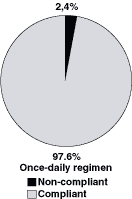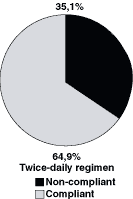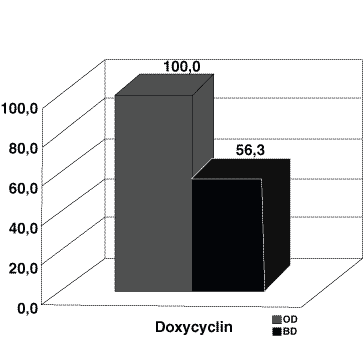|
The JOURNAL of APPLIED RESEARCH In Clinical and Experimental Therapeutics |
 |
| Current Issue |
| Previous Issues |
| Reprint Information |
| Back to The Journal of Applied Research |
Medical University of Lodz
Lodz, Poland; pkardas@csk.am.lodz.pl
This study was supported by a grant from the Medical
University of Lodz (502-11-704). The results were partly presented
at WONCA Europe 2002 Conference, London, June 9-13, 2002.
KEY WORDS: patient compliance, respiratory tract infections, drug therapy, antibiotics dosage, clinical trail
Abstract
Background: Patient compliance is essential for successful antibiotic therapy. The effect of the number of daily doses on it has already been well documented. However, in the case of antibiotic therapy of respiratory tract infections (RTIs), better patient compliance with once-daily dosage over twice-daily dosage has not been proven yet. The goal of this study was to evaluate whether once-daily dosage may provide better patient compliance than twice-daily dosage.
Materials and Methods: In this open study, outpatients aged 16 and older treated by general practitioners were enrolled. All patients were diagnosed with RTIs and were prescribed oral antibiotic therapy with once-daily or twice-daily dosage. Compliance was assessed on the fifth day of the therapy by used pill count during the home visit.
Results: Of 501 patients studied, 81.2% showed full compliance. Age, sex, marital status, education, and membership to a socioprofessional group did not affect patient compliance. The logistic regression model revealed that the only factor affecting compliance was the frequency of antibiotic dosage (P<0.00001; odds ratio = 21.4; 95% confidence interval, 8.2-55.7).
Conclusions: The once-daily dosage provides significantly better compliance with antibiotic therapy of RTI than twice-daily dosage.
Introduction
Respiratory tract infections (RTIs) are one of the most common reasons for patients to report to general practitioners.1 In numerous cases, these patients need antibiotic treatment. RTIs usually cause strongly expressed illness symptoms, which seem to motivate outpatients to comply with antibiotic treatment. However, a large number of patients are noncompliant with this medication.2 Consequently, noncompliance may lead to therapy ineffectiveness, complications or relapse, resistant pathogenic germs, increased hospitalization, and increase of direct and indirect treatment costs. Therefore, noncompliance constitutes a serious medical and social problem.3-5
In numerous studies evaluating different clinical situations, researchers noted that the frequency of drug dosage has a strong influence on patient compliance: the less frequent the doses the higher the compliance.6-8 Oral antibiotics administered once daily have recently become widely available. However, only limited studies have emphasized the advantage of using once-daily dosage over twice-daily dosage in obtaining a higher level of patient compliance with antibiotic therapy for RTIs.9-10
The goal of this study was to evaluate whether once-daily dosage may provide better patient compliance with antibiotics than twice-daily dosage. The relationship between basic sociodemographic factors and patient compliance was also investigated.
Materials and Methods
In this open study, patients treated by general practitioners in Lodz were enrolled. The inclusion criteria were 1) the diagnosis of RTI followed by antibiotic therapy in oral countable form (pills or capsules) with once-daily or twice-daily dosage and 2) informed consent. Exclusion criteria included 1) age younger than 16 years, 2) diagnosed psychiatric disease, 3) any state that could make the independent application of the medication difficult. When the medication was prescribed, the patients were informed that on the fifth day, counting from the day the antibiotic was prescribed, an investigator would visit their home to fill in a short questionnaire regarding the antibiotic therapy. However, they were not informed about the intention to count pills. On the fifth day from the antibiotic's prescription (or on the sixth day, if the patient was absent on the fifth day), a physician or investigator went to the patient's home, where the questionnaire was completed. Afterward, the pill count was performed by assessing the number of used pills in the original packaging of the antibiotic. The patient was asked if the drug was given to anyone else. The time of first dose usage was also noted. The study protocol was accepted by Ethical Committee of Medical University of Lodz.
Together with the new cases collected especially for this study, cases from two previous studies11,12 that met the above mentioned criteria (the dosage in the range of once-daily or twice-daily) were also re-analyzed in this paper.
Factors that could potentially affect patient compliance (age, sex, marital status, education, membership in a socioprofessional group, diagnosis, kind of antibiotic, frequency of antibiotic dosage, and the presence of adverse effects) were evaluated in one-factor analysis in a search for the influence on patient compliance. Afterwards, factors that affected patient compliance in statistically significant ways were assessed using logistic regression.
Results
Data from 501 patients were fully accessible and used for statistical analysis. The characteristics of the enrolled patients are shown in Table 1.
Pill count proved
full compliance in 81.2% of examined patients (407 persons). Ninety-four
patients (18.8%) took an improper number of antibiotic doses. Of these,
80 patients (16.0%) took fewer and 14 patients (2.8%) took more than
recommended.
Age, sex, marital status, education, and membership in a socioprofessional group did not show significant influences on compliance with physician's recommendations (Table 2). The factors with statistically significant influence on compliance in one-factor analysis (diagnosis, kind of antibiotic, dosage frequency, and occurrence of adverse effects) were assessed using logistic regression. That analysis proved that the only factor discriminating between patients who complied fully and those who did not was the antibiotic dosage (P<0.00001; odds ratio = 21.4; 95% confidence interval, 8.2-55.7). With once-daily dosage, 97.6% of patients complied with physician recommendations, whereas with twice-daily dosage only 64.9% complied (P<0,00001) (Figure 1). In case using clarithromycin and doxycycline, which were used in both once-daily and twice-daily dosages, the less frequent dosage was associated with better compliance (Figure 2).
Discussion
One of the most important reasons therapy is not effective is noncompliance with physician recommendations. From the clinical point of view, the most important form of noncompliance is noncompliance with medication. Numerous studies have shown that among patients with chronic diseases, only 50% to 60% of patients comply with recommendations; 30% to 40% of patients partially comply, and 5% to 10% of patients do not comply.13
In cases of antibiotic therapy in RTIs, the compliance rate is higher than in cases of chronic diseases therapy. There is no doubt that that difference is caused by patients' strong motivation combined with the unpleasant symptoms of RTIs. The short duration of administered therapy is also very important. However, in cases of antibiotic therapy of RTIs, a significant percentage of patients do not comply with physician recommendations.14,15 The main noncompliance during antibiotic therapy for RTIs is early discontinuation. This phenomenon is connected with receding of disease symptoms.16 What follows-even relatively small elongations of therapy can significantly increase the percentage of noncompliant patients.17-19
In a study assessing compliance during treatment with penicillin of streptococcal infections, on the third day of therapy, 44% of children were fully compliant, on the sixth day 29% were, and on the ninth day only 18% were fully compliant.20 The results of this study confirm that even during short-term antibiotic therapy (the initial 5 days of therapy were examined) every fifth patient does not fully comply with physician recommendations and omits some doses. Taking into consideration the consequences of that phenomenon, it indicates the essential need to find methods of increasing compliance during antibiotic therapy of RTIs.
Although age, sex, marital status, education, and membership in a socioprofessional group could be expected to affect compliance, many studies have proven that those factors do not have significant influence on that phenomenon.6,7,21 This is of special concerns with antibiotic therapy, especially therapy for RTIs.22,23 Results of the present study confirm this rule. It contradicts general wisdom and explains why it is so difficult for physicians to predict who will comply with recommendations and who will not.6,24
This study did not reveal the influence of formal education on compliance. Moreover, many studies prove that patients' education has no influence on that phenomenon. For instance, one study indicates that a similar percentage of patients did not comply with preventive use of penicillin in sickle cell disease in both intervention and nonintervention groups, although one group participated in special lectures that explained the nature of the disease and received weekly phone calls.25 Therefore, spending more time and giving these patients sufficient medical information will not be enough to ensuring compliance.
In these situations, clinicians may be interested in factors that improve patient compliance with antibiotics. Dosage frequency seems to be a significant factor. According to a review that only included studies conducted with the use of precise electronic compliance measurements, the mean compliance was 79% for once-daily dosage, 69% for the twice-daily dosage, 65% for the thrice-daily dosage, and 51% for four-times-a-day dosage.7 However, the difference between compliance levels with the once-daily and twice-daily dosage was not statistically significant.
The influence of dosage on the compliance with physician's recommendations was also evaluated in studies that considered antibiotic therapy of RTIs.8,14,15,24,26-29 However, there is a lack of data that could unambiguously prove the superiority of once-daily dosage versus twice-daily dosage. Meanwhile, a recent introduction of oral antibiotics with once-daily dosing to common use has made the question of superiority over twice-daily dosing very important from the clinical point of view.
The results of the
present study point unambiguously at significantly better patient
compliance with short-term antibiotic therapy for once-daily doses
compared with twice-daily dosage. Strongly convincing is the fact
that almost 100% of patients who were given antibiotics at once-daily
doses took the correct number. However every third patient taking
the antibiotics twice daily during first 5 days of therapy took an
incorrect (too small) number of antibiotic doses. In general, patients
who were prescribed antibiotics in a once-daily regimen had an over
20 times larger chance of being compliant with physician recommendations
than patients who were prescribed antibiotic with twice-daily dosage.
This study suggests that significant benefits for patients could result
from the physician's choice of an antibiotic with once-daily doses
for the treatment of RTIs.
References
1. McGregor A, Dovey S, Tilyard M. Antibiotic use in upper respiratory tract infections in New Zeland. Fam Pract 12:166-70, 1995.
2. Kardas P: Patient compliance with antibiotic treatment for respiratory tract infections. J Antimicrob Chemother 49:897-903, 2002.
3. Pechere JC, Lacey L: Optimizing economic outcomes in antibiotic therapy of patients with acute bacterial exacerbations of chronic bronchitis. J Antimicrob Chemother 45:19-24, 2000.
4. Pradier C, Dunais B, Carsenti-Etesse H, Dellamonica P: Pneumococcal resistance patterns in Europe. Eur J Clin Microbiol Infect Dis 16:644-647, 1997.
5. Wandstrat TL, Kaplan B: Pharmacoeconomic impact of factors affecting compliance with antibiotic regimens in the treatment of acute otitis media. Pediatr Infect Dis J 16:S27-S29, 1999.
6. Greenberg RN: Overview of patient compliance with medication dosing: A literature review. Clin Ther 6:592-599, 1984.
7. Claxton AJ, Cramer J, Pierce C: A systematic review of the association between dose regimens and medication compliance. Clin Ther 23:1296-1310, 2001.
8. Cockburn J, Gibberd RW, Reid AL, Sanson-Fisher RW: Determinants of non-compliance with short-term antibiotic regimens. BMJ 295:814-818, 1987.
9. Alvarez MP, Simon M, Sanchez S, et al: Pharmacovigilance study of azithromycin tablets (500 mg) in the treatment of adult patients with respiratory tract infections. Rev Esp Quimioter 13:297-305, 2000.
10. Sclar DA, Tartaglione TA, Fine MJ: Overview of issues related to medical compliance with implications for outpatient management of infectious diseases. Infect Agents Dis 3:266-273, 1994.
11. Kardas P: Compliance to antibiotics in out-patients treated for respiratory infections. Pneumonol Alergol Pol 67:398-408, 1999.
12. Kardas P, Ratajczyk-Pakalska E: Patient adherence in respiratory tract infections: Ceftibuten versus other antibiotics (PRATICULAR study). Pol Merkuriusz Lek 10:445-449, 2001.
13. Rudd P: Compliance with antihypertensive therapy:
A shifting paradigm. Cardiol Rev 2:230-240, 1994.
14. Ramalle-Gomara E, Bermejo-Ascorbe R, Alonso Marin R, et al: Compliance with antibiotic treatment in nonhospitalized children. Aten Primaria 24:364-367, 1999.
15. Reyes H, Guiscafre H, Munoz O, et al: Antibiotic noncompliance and waste in upper respiratory infections and acute diarrhea. J Clin Epidemiol 50:1297-1304, 1997.
16. Gil VF, Paya MA, Asensio MA, et al: Non-compliance of the treatment with antibiotics in non-severe acute infections. Med Clin (Barc) 112:731-33, 1999.
17. Carbon C, Chatelin A, Bingen E, et al: A double-blind randomized trial comparing the efficacy and safety of 5-day course of cefotaxim hexitil andthat of a 10-day course of penicillin V in adult patients with pharyngitis caused by group A beta-haemolytic streptococci. J Antimicrob Chemother 35:843-854, 1995.
18. Hoppe JE, Blumenstock G, Grotz W, Selbmann HK: Compliance of German pediatric patients with oral antibiotic therapy: Results of a nationwide study. Pediatr Infect Dis J 18:1085-1091, 1999.
19. Schrag SJ, Pena C, Fernandez J, et al: Effect of short-course, high-dose amoxicillin therapy on resistant pneumococcal carriage: A randomized trial. JAMA 286:49-56, 2001.
20. Bergman AB, Werner RJ: Failure of children to receive penicillin by mouth. N Engl J Med 268:1334-1338, 1963.
21. Mellins RB, Zimmerman B, Clark NM: Patient compliance:
Are we wasting our time and don't know it? Am Rev Respir Dis 146:1376-1377,
1992.
22. Cheung R, Sullens CM, Seal D, et al: The paradox of using a 7 day antibacterial course to treat urinary tract infections in the community. Br J Clin Pharmacol 26:391-398, 1988.
23. Augenbraun M, Bachmann L, Wallace T, et al: Compliance with doxycycline therapy in sexually transmitted diseases clinics. Sex Transm Dis 25:12-13, 1998.
24. Cockburn J, Reid AL, Bowman JA, Sanson-Fisher RW: Effects of intervention on antibiotic compliance in patients in general practice. Med J Aust 147:324-328, 1987.
25. Berkovitch M, Papadouris D, Shaw D, et al: Trying
to improve compliance with prophylactic penicillin therapy in children
with sickle cell disease. Br J Clin Pharmacol 45:605-607, 1998.
26. Lauvau DV, Verbist L: An open, multicenter, comparative study of the efficacy and safety of azithromycin and co-amoxiclav in the treatment of upper and lower respiratory tract infections in children. The Paediatric Azithromycin Study Group. J Int Med Res 25:285-295, 1997.
27. Sanson-Fisher R, Bowman J, Armstrong S: Factors affecting nonadherence with antibiotics. Diagn Microbiol Infect Dis 15(Suppl 4):103S-109S, 1992.
28. Hosie J, Quinn P, Smits P, Sides G: A comparison of 5 days of dirithromycin and 7 days of clarithromycin in acute bacterial exacerbation of chronic bronchitis. J Antimicrob Chemother 36:173-183, 1995.
37. Davey P, Parker S: Cost effectiveness
of once-daily oral antimicrobial therapy. J Clin Pharmacol 32:706-710,
1992.
Table 1. The Profile of Studied Patients
Factor
N %
Gender:
Female 340 67.9
Male 161 32.1
Marital status*:
Unmarried 89 17.7
Married 316 63.1
Divorced 20 4.0
Widowed 75 15.0
Education*:
Elementary 96 19.2
Secondary 266 53.1
College or higher 138 27.6
Socio-professional group*
Unemployed 24 4.8
Working 230 45.9
Retired or
196 39.1
pensioner
Student/pupil 49 9.8
Age (years)*:
Mean ± SD (range)
Together: 49.5±18.4 (16-93)
Female: 51.2±17.9 (16-93)
Male: 45.9±19.1 (16-85)
Diagnosis:
Upper RTI 277 55.3
Lower RTI 224 44.7
Applied antibiotic (regimen)
Amoxicillin (bd) 39 7.8
Amoxicillin +
clavulanic acid (bd) 16 3.2
Azithromycin (od) 24 4.8
Cefaclor (bd) 16 3.2
Cafadroxil (bd) 34 6.8
Cefalexin (bd) 3 0.6
Ceftibuten (od) 208 41.5
Cefuroxime (bd) 7 1.4
Ciprofloxacin (bd) 6 1.2
Clarithromycin (od) 3 0.6
Clarithromycin (bd) 19 3.8
Doxycycline (od) 15 3.0
Doxycycline (bd) 32 6.4
Roxithromycin (bd) 21 4.2
Spiramycin (bd) 58 11.6
Antibiotic dosage
od 250 49.9
bd 251 50.1
Adverse effects
Present 69 13.8
Absent 432 86.2
Together 501 100.0
*The
categories "others" and "no data" were omitted. od, once-daily; bd,
twice-daily.
Table 2. The Influence of Different Factors on
Patient Compliance During Antibiotic Therapy for RTIs
Factor P value
(NS, P>0.05)
Age NS
Sex NS
Marital status NS
Education NS
Socio-professional group NS
Diagnosis P<0.05
Applied antibiotic P<0.00001
Antibiotic dosage P<0.00001
Adverse
effects
P<0.01
Figure 1. The effect of antibiotic dosage on patient
compliance for RTIs therapy. Percentages of compliant and noncompliant
patients are marked.


Figure 2. The percentage of patients compliant with
od and bd doxycycline depends on the number of daily doses. *P<0.01.

©2000-2013. All Rights Reserved. Veterinary Solutions LLC
2Checkout.com is an authorized retailer for The
Journal of Applied Research